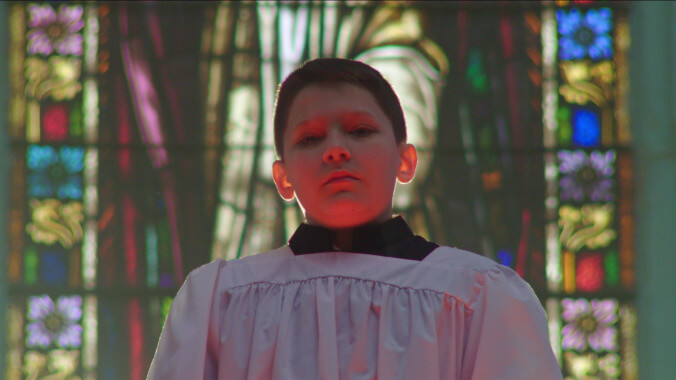Sexual abuse survivors direct their own stories in the poignant Procession
Robert Greene’s documentary examines trauma through an audacious filmmaking experiment


Irrespective of subject matter, the unconventional nonfiction films of Robert Greene are all, in essence, behind-the-scenes documentaries. Kate Plays Christine turns the true story of a TV reporter who killed herself live on the air into a brain-teasingly meta movie-within-a-movie; Bisbee ’17 casts the residents of a small Arizona town in a Brechtian reenactment of an episode from their community’s past. These idiosyncratic and self-reflexive films wield the making-of process as a metaphor, openly questioning the documentary format’s claims to reality and blurring the line between past and present, the real world and its staged opposite.
The message, in effect, is that we are all actors playing multiple roles. Greene’s latest, the empathetic Procession, takes this theme in a new and therapeutic direction. At its center are five middle-aged men who were all sexually abused as children by Catholic priests from the diocese of Kansas City, Missouri. With the help of Greene and a therapist who uses theatrical exercises in her work, they have agreed to take part in an elaborate experiment. They will create a series of short films based on their experiences—writing scripts, building sets, scouting churches for filming (some of them haven’t set foot in one in decades), directing actors, and, in some cases, acting on-camera themselves. A sixth man, unable to tell his story because he’s currently suing the church, joins the project as a cast member.
Unlike with Greene’s other films, it’s actually possible to imagine what a run-of-the-mill version of this concept would look like: introduction of the participants; the project being assembled; setbacks and pre-production woes; the back-to-back filming of shorts as a feel-good climax. But Greene isn’t out to manufacture catharsis. A very gifted editor (his résumé in that department includes Approaching The Elephant and many films by Alex Ross Perry), he plays fast and loose with chronology, pacing excerpts from the shorts across the film, sometimes cutting them with outtakes and set footage, to the effect that everything blends together seamlessly. (Rarely has the filmmaker’s penchant for artificialities and distancing effects seemed less obtrusive.)
The use of a project-within-the-project is something Greene has done before, and something that’s always intriguing in documentaries. Joshua Oppenheimer’s modern classic The Act Of Killing used it to stomach-churning effect in its exploration of the 1965-66 mass killings in Indonesia. Procession, with its emphasis on emotional space, could be that film’s polar opposite. Greene doesn’t dwell on how the project came together or the psychological theories behind it. Ultimately, it is about these men and their struggle to put their traumas and frustrations into words (and, in this case, images).
It is also about the roles they end up playing in each other’s lives: exchanging creative ideas, staining plywood to re-create the cathedral rectory where one of them was molested. Morbidly, many of them end up playing priests on camera—in some cases, playing each other’s abusers. A single young actor is cast to play all of their childhood selves, and their protective relationships with the boy provides the film with a touching through-line.
Obvious symbolism abounds, just as it does in real life. In fact, it’s the subject of symbolism that the men keep returning to again and again: what parish priests and the institution of the church symbolized for their deeply Catholic families; the painful memories now invoked by confessionals and the smell of churchy incense; the symbolism in their recurring nightmares. Such is the nature of trauma. It doesn’t want to be discussed out loud; it hides and thrives in subtexts and signs. The project at the center of Procession is, in some ways, only symbolic—the film doesn’t pretend that it will offer these men either closure or consolation. Their abusers remain protected by statutes of limitations and church inaction. (As to the abusers’ identities, Greene isn’t cagey: We’re given names, parishes, timelines.)
But at least the project gives the men creative control over the symbols and memories that have haunted their lives. Their shorts vary in style. One participant, Mike, who’s gruff and prone to expletive-filled rants against the church, opts to restage the day his parents made him deliver a chocolate cake to the priest who molested him. Ed, a New York City construction contractor, meticulously storyboards an artistically ambitious short with rapid montages of close-ups inspired by the opening of All That Jazz. Dan, who works as a location scout for commercial and TV production, decides to film on the property where he was raped. In one of Procession’s more heartrending sequences, he struggles to find it decades later. Did he get the address wrong? Did it really happen as he remembered?
The combination of darkly personal subject matter and the shorts’ go-for-broke execution (complete with low-budget digital effects and improvised fourth-wall-breaking speeches) means that there’s always a potential for Procession to veer into the grotesquely curious. But Greene, whose earliest documentaries were rooted in the cinéma vérité tradition and its portraits of ordinary American lives, has crafted a poignant group portrait with something to say about the crossed wires of pain and memory. In one of the film’s most haunting images, Ed, the construction contractor, returns to the cathedral where he was once an altar boy. He is allowed to ring the bell again. As he yanks down on the steel cable, the expression on his face changes from trepidation to joy. He may be revisiting the most painful moments of his life, but also the happiest.